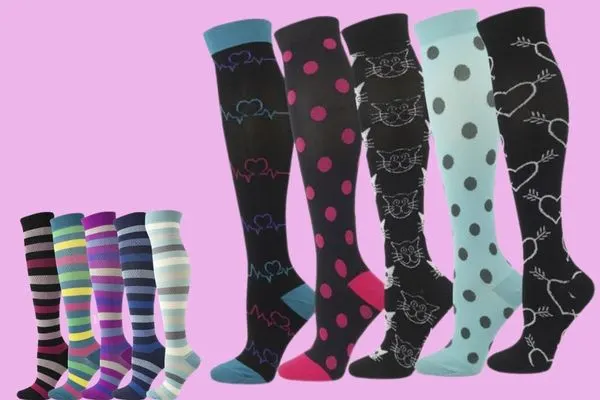As frontline healthcare workers, nurses play a crucial role in patient care. They often spend long hours on their feet, performing physically demanding tasks that can take a toll on their bodies. One of the ways that nurses can protect their health and improve their comfort during their work is by wearing compression socks. In this article, we’ll explore what compression socks are, the benefits of wearing them, how to choose and wear them, and possible side effects or risks.

Read our latest on Nurse Hats
What Are Compression Socks?
Compression socks are special hosiery that provides graduated compression to the legs. This means that the compression is highest at the ankle and gradually decreases as it moves up the leg.
These special socks are made of elastic materials that help to improve blood flow and prevent fluid from pooling in the legs. In addition, they are available in different levels of compression, which are measured in millimeters of mercury (mmHg). The higher the mmHg, the more pressure the sock applies.

The Benefits of Compression Socks for Nurses
Compression socks offer several benefits that can be particularly helpful for nurses. Here are some of the main advantages of wearing them:

Improved Circulation and Reduced Swelling
Firstly, compression socks help to improve circulation by squeezing the veins in the legs, which helps to push blood back up to the heart. This can reduce swelling and the risk of developing blood clots, which can be a serious health concern for nurses who spend long hours on their feet.
Increased Comfort and Reduced Fatigue
Secondly, the pressure that compression socks apply to the legs can also help to reduce muscle fatigue and soreness. Nurses who wear these socks report feeling less discomfort and tiredness at the end of their shift.
Prevention of Varicose Veins and Other Leg Problems
Finally, varicose veins are a common problem among healthcare workers who spend long periods standing or sitting. These special socks can help to prevent or reduce the appearance of varicose veins and other leg problems by improving blood flow and reducing swelling.

How to Choose and Wear Compression Socks
Choosing the right compression socks can make a big difference in how effective they are and how comfortable they feel. Here are some tips for selecting and wearing compression socks:
Choose the Right Level of Compression
Compression socks are available in different levels of compression, ranging from 8-15 mmHg to 30-40 mmHg. Nurses who are new to compression socks should start with a lower level of compression and gradually work their way up. A healthcare provider can help to determine the appropriate level of compression based on the nurse’s needs and health status.
Get the Right Fit
Compression socks should fit snugly but not be too tight. It’s important to measure the legs accurately to ensure a proper fit. Nurses should measure their legs in the morning when swelling is at its lowest, and use the manufacturer’s sizing chart to select the appropriate size.
Wear Compression Socks Correctly
Compression socks should be put on first thing in the morning and worn throughout the day. They should be pulled up gradually, smoothing out any wrinkles or folds. Consequently, nurses should avoid rolling down the tops of the socks, as this can create a tourniquet effect and impede blood flow.

Possible Side Effects or Risks
While compression socks are generally safe for most people, they can cause side effects or risks in some cases. These may include:
- Skin irritation or rash
- Pressure sores or ulcers
- Restricted blood flow
- Allergic reaction to materials used in the socks
Nurses who experience any of these symptoms should stop wearing compression socks and consult with their healthcare provider.

Conclusion
In summary, compression socks can be an effective and affordable way for nurses to protect their health and improve their comfort during their work. They offer a range of benefits, including improved circulation, reduced swelling, increased comfort, and the prevention of leg problems like varicose veins.
As such, nurses who are considering wearing these special socks should choose the right level of compression, get the right fit, and wear them correctly to maximize their benefits. While there are some possible side effects or risks, these are generally rare. As long as you follow the manufacturer’s instructions and consulting with a healthcare provider there shouldn’t be any problem.
By taking care of their bodies and wearing compression socks, nurses can continue to provide excellent patient care with fewer physical discomforts.

References
An, G., & Kim, K. (2019). Compression stockings for deep vein thrombosis prevention in the clinical practice guideline era: is it still necessary?. Journal of Korean medical science, 34(20), e162. https://doi.org/10.3346/jkms.2019.34.e162
Mosti, G., Partsch, H., & Mattaliano, V. (2014). Comparison between three compression stockings brands: a cross-sectional study of healthy nurses. International wound journal, 11(4), 368-373. https://doi.org/10.1111/iwj.12052
Tague, N. R., & Vasquez, M. A. (2019). Compression socks: a review of their efficacy and purpose. Journal of the American Association of Nurse Practitioners, 31(7), 401-406. https://doi.org/10.1097/JXX.0000000000000289